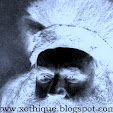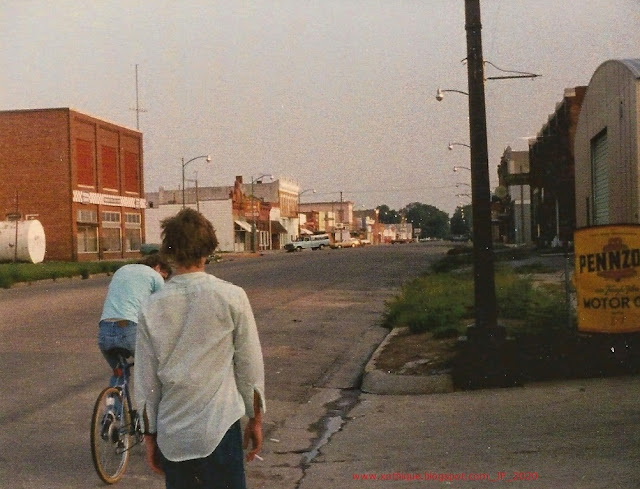Visiting Newave Artists in Nebraska (March, 1985)
I had the fortune recently to meet two artistic spawn of the horizontal corn-hell known as Nebraska. These two young self-publishers, Marc Myers and Clark Dissmeyer, may provide their state's first chance to redeem itself since the time it spewed S. Clay Wilson into the world.
As a life-long denizen of the great & mountainous west, the trip itself was a weird experience for me. Departing from Denver at 9:00 PM (on a Trailways bus), and traveling wide-awake through alien towns such as Brush, Otis, and McCook (where Clark once worked briefly as a rabbit-shit shoveler), I felt I was entering a land of no-return. The farmers and grain elevators and endless fields of wheat convey a sense of the sinister as well as of the earthy and mundane, perhaps the very awful sterility of the landscape & people turns the vision inward, to the point where parades of hallucinatory images march by as in a collage of Marc's. At any rate, time has fossilized in its tracks here since the 1950s or before...
Arriving in Grand Island not long after 7:00 AM the next morning, I ate at the nearest fast food slophouse, after which I phoned Clark; awakened from his slumbers, he promised to be out shortly. As he and a relative (his stepfather) traversed the 40 miles from Fullerton to G.I., I sat in the bus depot and meditated on the game shows the attendant, the only other person, watched.
An hour or two later, a tall figure clad in denim entered; of course, I knew instantly the identity of the person. Dragging on a generic cigarette, with curly longish hair, a day or two of stubble, Clark took me out to the car and we departed for Fullerton.
His cohort Marc still in Omaha (where he now resides), Clark and I talked about everything from the mystical composer Scriabin, to Bugs Bunny and Daffy Duck. The ride from G.I. to the farming hub of Fullerton covers extremely boring territory, the only objects I noticed being the rotting husks of barns & concrete grain elevators. We compared our respective territories, I expounding on the colour & variety of the "far west," Clark trying to picture this while looking at the center of Nebraska.
Fullerton is an isolated town of 1,500. As we first drove through it I had a strange, peaceful impression which didn't cease as we arrived at Clark's house around noon. After spending time with his folks, the artist and I descended to his basement hermitage, there to talk, listen to tapes and look at books and comix. After the noon meal, we went on a walk, to the "old dam" long since disused, and by the gigantic grain elevator, where we were unexpectedly blasted by hot air coming from a tube, something to do with preparing grain, I imagined. I'd also noticed a few long swivel-headed stares from the locals, no doubt stemming from my status as a stranger and reprobate.
That night Marc Myers, creator of Stick and countless other publications, arrived from Omaha, and we met him at his turn-of-the-century house. He took us up to his small upstairs room, where for a couple of hours the three of us scanned his remarkable paintings and surreal notebooks, observed abstract and multi-layered slides, exchanged a few gifts, and spoke.
We finished the night by visiting the town's graveyard, the celestial vault reeking with unimaginable beauty. After heading to Myers' Appliance, we ended up at Clark's place, played an incoherent game of ping-pong. Having been in a state of waking consciousness for around 40 hours, I finally fell into bed, falling asleep within a few seconds. That night I dreamt of Marc nonchalantly carrying a blood-spattered corpse in his arms.
An odd incident occurred the night before I landed in Fullerton -- a person named Schreck (same as the mysterious actor who portrayed Count Orlok in the silent masterpiece Nosferatu), was crushed to death by a pin-setter in the town's bowling alley. I couldn't help thinking that this might have been intended as a signal to me, from who knows who or what? At any rate, an assortment of photos were taken of Clark, Marc, and me in front of the alley where the death took place.
The morning after my arrival I awoke fairly early. Clark still slumbered, but after deliberation on the subject of early rising by his stepfather the artist was awakened, and appeared sleepily in the kitchen. Some trouble had arisen the day before, as Marc had come from Omaha to Central City, about twenty miles away, in honour of my visit. He was unable to contact his parents & was contemplating hitch-hiking, but C. finally managed to locate M.'s mother & the problem was over.
On the second day, we ate some bread, miso, & seaweed (after I ate a traditional breakfast of eggs) -- on the first day, as Clark and I walked down railroad tracks, someone in a passing school bus shouted at us "smoke a doobie for me!" 'Twas on day two or three, I'm not certain which, that we went on a fairly long walk, M., C., and I. Walking through the town, we came out on the highway, hiking along the pavement for some distance, evidently came to some prearranged spot, and crossed a barbed-wire fence & walked through a farmer's field. Cow manure dotted the ground but no cows could be seen.
The ground was hard and irregular, covered with dead, brown grass. Barren trees always in the distance. After walking for about twenty minutes, we spotted a white-tail deer crashing away from us, about two hundred feet in distance.
After we took several different pictures, Clark made the remark: "Maybe someday there'll be an Arkham House book with these pictures of us out here." He also made reference to the future book of "Dissmeyer/Falk correspondence." I did my famous impression of the redneck old-boy whilst out on these solemn wastes. We eventually came to a gradually rising stretch of land; Clark at one point ascended before us and tossed cow pies, hard & white, for great distances. At the top lay our objective -- "The Leap!" Actually, we weren't immediately at this much discussed spot; "The Leap" does not come until the end of the great arm of land we stood upon.
(And there the piece suddenly ended. One memory I didn't include, from my time in Fullerton, was of a drunken electric guitar performance by the three of us, in Marc's father's shop. I also met several of my friends' former teachers.)
-- Jonathan Falk
I originally wrote this (recently-slightly edited) account around April or May, in 1985. This was shortly after my first visit to Nebraska (at that time, the furthest east I'd been), in March, 1985.
Marc and Clark, photo by me; visiting Fullerton, Nebraska, in August, 1986, a year and five month after my first trip there.




























